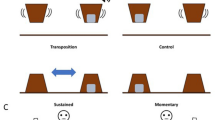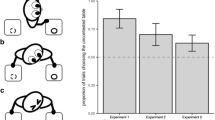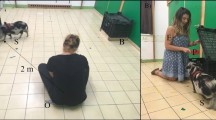Abstract
Recently, comparative research on the mechanisms and species-specific adaptive values of attributing attentive states and using communicative cues has gained increased interest, particularly in non-human primates, birds, and dogs. Here, we investigate these phenomena in a farm animal species, the dwarf goat (Capra aegagrus hircus). In the first experiment, we investigated the effects of different human head and body orientations, as well as human experimenter presence/absence, on the behaviour of goats in a food-anticipating paradigm. Over a 30-s interval, the experimenter engaged in one of four different postures or behaviours (head and body towards the subject—'Control', head to the side, head and body away from the subject, or leaving the room) before delivering a reward. We found that the level of subjects’ active anticipatory behaviour was highest in the control condition and decreased with a decreasing level of attention paid to the subject by the experimenter. Additionally, goats ‘stared’ (i.e. stood alert) at the experimental set-up for significantly more time when the experimenter was present but paid less attention to the subject (‘Head’ and ‘Back’ condition) than in the ‘Control’ and ‘Out’ conditions. In a second experiment, the experimenter provided different human-given cues that indicated the location of a hidden food reward in a two-way object choice task. Goats were able to use both ‘Touch’ and ‘Point’ cues to infer the correct location of the reward but did not perform above the level expected by chance in the ‘Head only’ condition. We conclude that goats are able to differentiate among different body postures of a human, including head orientation; however, despite their success at using multiple physical human cues, they fail to spontaneously use human head direction as a cue in a food-related context.



Similar content being viewed by others
References
Baciadonna L, McElligott AG, Briefer EF (2013) Goats favour personal over social information in an experimental foraging task. PeerJ 1:e172. doi:10.7717/peerj.172
Bania AE, Stromberg EE (2013) The effect of body orientation on judgments of human visual attention in western lowland gorillas (Gorilla gorilla gorilla). J Comp Psychol 127:82–90. doi:10.1037/a0027261
Bolles RC (1968) Anticipatory general activity in thirsty rats. J Comp Physiol Psychol 65:511–513
Botting JL, Wiper ML, Anderson JR (2011) Brown (Eulemur fulvus) and ring-tailed lemurs (Lemur catta) use human head orientation as a cue to gaze direction in a food choice task. Folia Primatol 82:165–176. doi:10.1159/000333142
Bourjade M, Meguerditchian A, Maille A et al (2014) Olive baboons, Papio anubis, adjust their visual and auditory intentional gestures to the visual attention of others. Anim Behav 87:121–128. doi:10.1016/j.anbehav.2013.10.019
Bräuer J, Call J, Tomasello M (2005) All great ape species follow gaze to distant locations and around barriers. J Comp Psychol 119:145–154. doi:10.1037/0735-7036.119.2.145
Briefer EF, Haque S, Baciadonna L, McElligott AG (2014) Goats excel at learning and remembering a highly novel cognitive task. Front Zool 11:20. doi:10.1186/1742-9994-11-20
Bugnyar T, Stöwe M, Heinrich B (2004) Ravens, Corvus corax, follow gaze direction of humans around obstacles. Proc Biol Sci 271:1331–1336. doi:10.1098/rspb.2004.2738
Bulloch MJ, Boysen ST, Furlong EE (2008) Visual attention and its relation to knowledge states in chimpanzees, Pan troglodytes. Anim Behav 76:1147–1155. doi:10.1016/j.anbehav.2008.01.033
Butz MV, Sigaud O, Gérard P (2003) Anticipatory behavior: exploiting knowledge about the future to improve current behavior. Anticip Behav Adapt Learn Syst Found Theor Syst Springer, pp 1–10
Craig W (1918) Appetites and aversions as constituents of instincts. Biol Bull 34:91–107
Davidson GL, Butler S, Fernández-Juricic E et al (2014) Gaze sensitivity: function and mechanisms from sensory and cognitive perspectives. Anim Behav 87:3–15. doi:10.1016/j.anbehav.2013.10.024
Flombaum JI, Santos LR (2005) Rhesus monkeys attribute perceptions to others. Curr Biol 15:447–452. doi:10.1016/j.cub.2004.12.076
Gácsi M, Miklosi A, Varga O et al (2004) Are readers of our face readers of our minds? Dogs (Canis familiaris) show situation-dependent recognition of human’s attention. Anim Cogn 7:144–153. doi:10.1007/s10071-003-0205-8
Gaunet F, Deputte BL (2011) Functionally referential and intentional communication in the domestic dog: effects of spatial and social contexts. Anim Cogn 14:849–860. doi:10.1007/s10071-011-0418-1
Giret N, Miklósi Á, Kreutzer M, Bovet D (2009) Use of experimenter-given cues by African gray parrots (Psittacus erithacus). Anim Cogn 12:1–10. doi:10.1007/s10071-008-0163-2
Gómez J-C (2005a) Species comparative studies and cognitive development. Trends Cogn Sci 9:118–125. doi:10.1016/j.tics.2005.01.004
Gómez J-C (2005b) Requesting gestures in captive monkeys and apes: conditioned responses or referential behaviours? Gesture 5:91–105. doi:10.1075/gest.5.1.08gom
Hansen SW, Jeppesen LL (2006) Temperament, stereotypies and anticipatory behaviour as measures of welfare in mink. Appl Anim Behav Sci 99:172–182. doi:10.1016/j.applanim.2005.10.005
Hare B, Tomasello M (2005) The emotional reactivity hypothesis and cognitive evolution. Trends Cogn Sci 9:464–465. doi:10.1016/j.tics.2005.08.010
Hare B, Brown M, Williamson C, Tomasello M (2002) The domestication of social cognition in dogs. Science 298:1634–1636. doi:10.1126/science.1072702
Hattori Y, Kuroshima H, Fujita K (2007) I know you are not looking at me: capuchin monkeys´ (Cebus apella) sensitivity to human attentional states. Anim Cogn 10:141–148. doi:10.1007/s10071-006-0049-0
Hooks MS, Jones GH, Juncos JL et al (1994) Individual differences in schedule-induced and conditioned behaviours. Behav Brain Res 60:199–209
Imfeld-Mueller S, Hillmann E (2012) Anticipation of a food ball increases short-term activity levels in growing pigs. Appl Anim Behav Sci 137:23–29. doi:10.1016/j.applanim.2012.01.012
Kaminski J, Call J, Tomasello M (2004) Body orientation and face orientation: two factors controlling apes’ behavior from humans. Anim Cogn 7:216–223. doi:10.1007/s10071-004-0214-2
Kaminski J, Riedel J, Call J, Tomasello M (2005) Domestic goats, Capra hircus, follow gaze direction and use social cues in an object choice task. Anim Behav 69:11–18. doi:10.1016/j.anbehav.2004.05.008
Loretto M-C, Schloegl C, Bugnyar T (2010) Northern bald ibises follow others’ gaze into distant space but not behind barriers. Biol Lett 6:14–17. doi:10.1098/rsbl.2009.0510
Maille A, Engelhart L, Bourjade M, Blois-Heulin C (2012) To beg, or not to beg? That is the question: mangabeys modify their production of requesting gestures in response to human’s attentional states. PLoS ONE 7:e41197. doi:10.1371/journal.pone.0041197
Maros K, Gácsi M, Miklósi Á (2008) Comprehension of human pointing gestures in horses (Equus caballus). Anim Cogn 11:457–466. doi:10.1007/s10071-008-0136-5
McKinley J, Sambrook TD (2000) Use of human-given cues by domestic dogs (Canis familiaris) and horses (Equus caballus). Anim Cogn 3:13–22. doi:10.1007/s100710050046
Miklósi A, Soproni K (2006) A comparative analysis of animals’ understanding of the human pointing gesture. Anim Cogn 9:81–93. doi:10.1007/s10071-005-0008-1
Moe RO, Stubsjøen SM, Bohlin J et al (2012) Peripheral temperature drop in response to anticipation and consumption of a signaled palatable reward in laying hens (Gallus domesticus). Physiol Behav 106:527–533. doi:10.1016/j.physbeh.2012.03.032
Mulcahy NJ, Hedge V (2012) Are great apes tested with an abject object-choice task? Anim Behav 83:313–321. doi:10.1016/j.anbehav.2011.11.019
Müller C, Mayer C, Dörrenberg S et al (2011) Female but not male dogs respond to a size constancy violation. Biol Lett 7:689–691. doi:10.1098/rsbl.2011.0287
Nawroth C, Ebersbach M, von Borell E (2013) Are juvenile domestic pigs (Sus scrofa domestica) sensitive to the attentive states of humans?—The impact of impulsivity on choice behaviour. Behav Process 96:53–58. doi:10.1016/j.beproc.2013.03.002
Nawroth C, von Borell E, Langbein J (2014a) Exclusion performance in dwarf goats (Capra aegagrus hircus) and sheep (Ovis orientalis aries). PLoS ONE 9:e93534. doi:10.1371/journal.pone.0093534
Nawroth C, Ebersbach M, von Borell E (2014b) Juvenile domestic pigs (Sus scrofa domestica) use human-given cues in an object choice task. Anim Cogn 17:701–713. doi:10.1007/s10071-013-0702-3
Povinelli DJ, Eddy TJ (1996) What young chimpanzees know about seeing. Monogr Soc Res Child Dev 61:1–191
Proops L, McComb K (2010) Attributing attention: the use of human-given cues by domestic horses (Equus caballus). Anim Cogn 13:197–205. doi:10.1007/s10071-009-0257-5
Proops L, McComb K (2012) Cross-modal individual recognition in domestic horses (Equus caballus) extends to familiar humans. Proc R Soc B Biol Sci 279:3131–3138. doi:10.1098/rspb.2012.0626
Proops L, Walton M, McComb K (2010) The use of human-given cues by domestic horses, Equus caballus, during an object choice task. Anim Behav 79:1205–1209. doi:10.1016/j.anbehav.2010.02.015
Proops L, Rayner J, Taylor AM, McComb K (2013) The responses of young domestic horses to human-given cues. PLoS ONE 8:e67000. doi:10.1371/journal.pone.0067000
Range F, Virányi Z (2011) Development of gaze following abilities in wolves (Canis lupus). PLoS ONE 6:e16888
Rosati AG, Hare B (2009) Looking past the model species: diversity in gaze-following skills across primates. Curr Opin Neurobiol 19:45–51. doi:10.1016/j.conb.2009.03.002
Sandel AA, MacLean EL, Hare B (2011) Evidence from four lemur species that ringtailed lemur social cognition converges with that of haplorhine primates. Anim Behav 81:925–931. doi:10.1016/j.anbehav.2011.01.020
Scheumann M, Call J (2004) The use of experimenter-given cues by South African fur seals (Arctocephalus pusillus). Anim Cogn 7:224–230. doi:10.1007/s10071-004-0216-0
Schmidt J, Scheid C, Kotrschal K et al (2011) Gaze direction: a cue for hidden food in rooks (Corvus frugilegus)? Behav Processes 88:88–93. doi:10.1016/j.beproc.2011.08.002
Soproni K, Miklósi Á, Topál J, Csányi V (2001) Comprehension of human communicative signs in pet dogs (Canis familiaris). J Comp Psychol 115:122–126
Spruijt BM, Van den Bos R, Pijlman FTA (2001) A concept of welfare based on reward evaluating mechanisms in the brain: anticipatory behaviour as an indicator for the state of reward systems. Appl Anim Behav Sci 72:145–171
Tempelmann S, Kaminski J, Liebal K (2011) Focus on the essential: all great apes know when others are being attentive. Anim Cogn 14:433–439. doi:10.1007/s10071-011-0378-5
Tomasello M, Call J, Hare B (1998) Five primate species follow the visual gaze of conspecifics. Anim Behav 55:1063–1069
Udell MaR, Dorey NR, Wynne CDL (2008) Wolves outperform dogs in following human social cues. Anim Behav 76:1767–1773. doi:10.1016/j.anbehav.2008.07.028
Von Bayern AMP, Emery NJ (2009) Jackdaws respond to human attentional states and communicative cues in different contexts. Curr Biol 19:602–606. doi:10.1016/j.cub.2009.02.062
Wilkinson A, Mandl I, Bugnyar T, Huber L (2010) Gaze following in the red-footed tortoise (Geochelone carbonaria). Anim Cogn 13:765–769. doi:10.1007/s10071-010-0320-2
Zimmerman PH, Buijs SaF, Bolhuis JE, Keeling LJ (2011) Behaviour of domestic fowl in anticipation of positive and negative stimuli. Anim Behav 81:569–577. doi:10.1016/j.anbehav.2010.11.028
Acknowledgments
We would like to thank Katrin Siebert for data coding, Gerd Nürnberg for statistical advice, and Dieter Sehland and Heinz Deike for excellent technical assistance.
Author information
Authors and Affiliations
Corresponding author
Electronic supplementary material
Below is the link to the electronic supplementary material.
Supplementary material 1 (MP4 13,142 kb)
Supplementary material 2 (MP4 10,226 kb)
Rights and permissions
About this article
Cite this article
Nawroth, C., von Borell, E. & Langbein, J. ‘Goats that stare at men’: dwarf goats alter their behaviour in response to human head orientation, but do not spontaneously use head direction as a cue in a food-related context. Anim Cogn 18, 65–73 (2015). https://doi.org/10.1007/s10071-014-0777-5
Received:
Revised:
Accepted:
Published:
Issue Date:
DOI: https://doi.org/10.1007/s10071-014-0777-5




